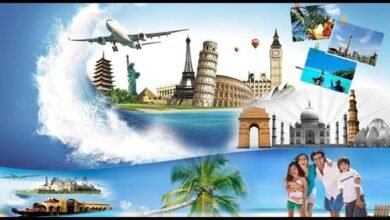
In Iceland, there are plenty of things to do while on vacation. But which method works best? How long should you spend there? On average, a 7-10 day trip is perfect for most travelers. It allows time for both the natural beauty and culture of the country. This duration allows for a journey through the Golden Circle and down South. It even leaves time to explore the North and Snaefellsnes Peninsulas. You will have an unforgettable adventure if you can set aside that much time.
Iceland: A Realm of Natural Splendors and Cultural Richness
-
The Land of Magic
Iceland stands strong in a realm where nature meets artificial design. This island’s spectacular beauty and extensive history make it unique.
It is impossible to witness every volcano, glacier, waterfall, and geothermal spring simultaneously. Yet somehow, it connects us by sharing its unique stories and traditions passed down through generations.
As beautiful as each site is on its own, this balance between Earth’s wonders and human influence makes every traveler fall in love with Iceland after just one visit.
Choosing Your Stay Length
-
How Many Days Is Enough?
If I had to give it a whirl, which I have to do, 7-10 days is the way to go. You will have plenty of opportunities to see all the attractions and fully immerse yourself in the authentic culture that has been thriving amid them for centuries during those lucky few days of your once-in-a-lifetime journey.
For example, the Golden Circle itinerary includes visits to Thingvellir National Park, the Geysir Geothermal Area, and the Gullfoss Waterfall.
You will understand why Icelanders highly value these magnificent locations after seeing them. If you do not know what that means, please look up photos now! Trust me, it’ll be worth every second spent down that rabbit hole.
Crafting Your Icelandic Journey: A Stepwise Guide
Days 1-3: The Golden Circle and Reykjavik’s Charms
-
The Golden Circle Exploration
Embark on an adventure where you’re in control, steering towards sights more breathtaking than any glacier or lava field could showcase. Navigate Iceland’s famed Golden Circle Route, where three iconic landmarks await your discovery.
Start with Thingvellir National Park, a place steeped in geological and historical significance, followed by the Geysir Geothermal Area, where the Earth’s power visibly erupts.
Finally, the Gullfoss Waterfall is an astounding exhibition of the power of nature. These places are not only breathtaking photo backgrounds, but they also act as heartbreaking reminders of how resilient our world is to threats caused by us, such as oil spills and fracking.
-
Learning about Reykjavik
The late 18th century saw the establishment of the most northern capital globally. It is also the world’s most beautiful city.
Its boundaries are home to several art and historical museums and well-known structures, including Old Harbour and Hallgrimskirkja Cathedral.
This place has all the ingredients that make up a vibrant community, too — cozy cafes and colorful houses line each street corner. After spending some time here, you’ll quickly realize Iceland isn’t just about pretty landscapes anymore!
Days 4-6: Southern Iceland’s Majestic Landscapes
-
Venturing South
Drive south of Reykjavik, and you’ll find some of Iceland’s most dramatic and magnificent landscapes, including famous waterfalls like Seljalandsfoss and Skogafoss.
Seeing icebergs wash across Jokulsarlon Glacier Lagoon is spectacular, while Reynisfjara Beach’s dark shores and white waters provide a dramatic contrast. If you want to visit Iceland, Learn How to Plan a Trip.
This is where Iceland does its thing, showing off so much natural beauty in one area that it makes no sense. Going south will give you all the answers if you want to know why Iceland is so unique.
-
Glacier Experiences
Experiencing glaciers here will allow you to get up close and personal with ancient ice giants! Hikers can cross frozen lands to see how massive Vatnajökull, Europe’s largest ice cap glacier, is.
Cave expeditions and boat tours are available, which give pretty different experiences but allow you to get closer than any other tour would! They show off blue ice formations, which are always breathtaking; not only that, but drifting icebergs are also in plain sight throughout these tours.
These experiences show people who come just how important it is for us to preserve these ecosystems since they’re so fragile. When you engage with glaciers, you can tell firsthand how mighty Mother Nature is.

Days 7-10: Northern Iceland and the Snaefellsnes Peninsula
-
Northern Adventures
This part of your trip will take you somewhere where nature’s best works shine bright… The northern region does not disappoint with diverse landscapes, as the volcanic Lake Myvatn area and thunderous Dettifoss waterfall are within reach here.
And once again, tourists can’t miss out on another scenic view along the Arctic coastline. If that doesn’t do it for you, then whale watching in Husavik will give you a chance to have some intimate encounters with marine life.
Although this is the same Iceland we know from previous parts of the trip, these are all different views that paint a better picture of what Iceland’s geographical differences look like and have to offer. If you’re genuinely interested in nature and its wonders, it is highly recommended that you explore the north.
Snaefellsnes Peninsula: A Miniature Version of Iceland
Travelers may quickly get up close and personal with various easily accessible yet different sceneries. This place is dominated by the Snaefellsjokull glacier volcano, which takes up a lot of space, but what makes it such an exciting visit is that this area represents everything else Iceland has to offer.
We’ve got cliffs and beaches, from rugged lava fields to calm fjords! Exploring this peninsula lets people experience all there is about Iceland’s geology and folklore, including its rich maritime history.
Within this exploration, we’ll discover many things about elves and trolls without venturing far from where we started our trip since it’s all pretty condensed.

Conclusion: Charting Your Icelandic Exploration
Remember that the country has so much to offer when planning how long your stay should be here in Iceland. Especial. Within nature.
However, if you plan on staying here for between 7 and 10 days, you can see almost everything! From volcanos on the Golden Circle side right down through glaciers on the southern coast.
This time frame provides enough time to dive into their history while exploring contemporary culture! So don’t worry about trying to fit everything into your itinerary — stay longer than a week if you wish. However, everything you need to learn and experience should be achieved.
FAQs
Should I know anything about budgeting for my trip?
While everything in Iceland tends to be more expensive than what we're used to, planning can help manage costs without cutting into the experience too much. Many of Iceland's natural attractions are free!
Can I see the Northern Lights all year round?
No, unfortunately not. The months when these lights are visible are usually between September and April. Remember that their visibility depends on weather conditions and solar activity, too!









